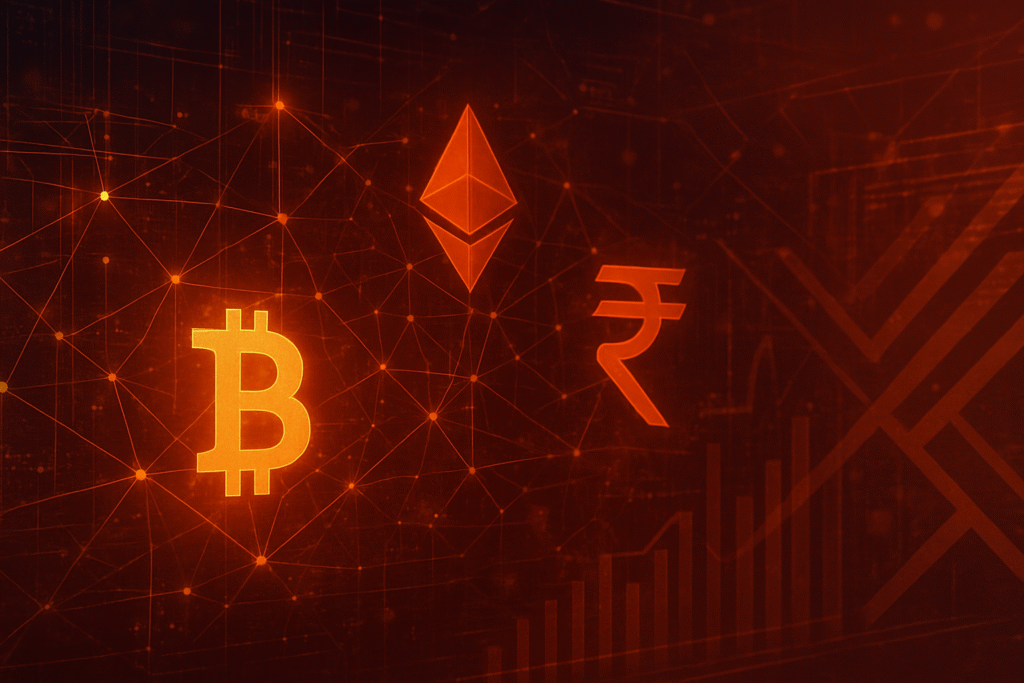
NEW DELHI, India – November 7, 2025 – India, a nation renowned for its technological prowess and burgeoning digital economy, finds itself at a critical juncture in the global cryptocurrency landscape. The Indian government's unique approach to digital assets – imposing a stringent tax regime without establishing a clear, comprehensive regulatory framework – has created a legal vacuum that continues to generate significant challenges for investors, businesses, and the broader crypto ecosystem. This "taxed but unregulated" stance, which began with the Union Budget 2022, has not only led to a drastic decline in domestic trading volumes but has also pushed billions in capital and countless innovators to offshore havens, raising serious questions about India's ambition to be a Web3 powerhouse.
The immediate aftermath of the 30% flat tax on virtual digital asset (VDA) gains, effective April 1, 2022, and the subsequent 1% Tax Deducted at Source (TDS) implemented on July 1, 2022, saw a palpable chill descend upon the Indian crypto market. Domestic exchanges reported unprecedented drops in trading activity, while the crypto community voiced widespread frustration over the punitive measures and the lack of clarity. This disparity is critical because it highlights a governmental desire to extract revenue from a burgeoning sector without providing the foundational legal structure, investor protection, or operational guidelines necessary for its healthy and responsible growth. The Supreme Court has even expressed concerns that this legislative vacuum facilitates misuse and financial irregularities, leaving investors vulnerable and hindering India's potential in the rapidly evolving global blockchain and Web3 space.
Market Impact and Price Action
The introduction of India's stringent crypto taxation framework in 2022, characterized by a flat 30% tax on Virtual Digital Asset (VDA) gains and a 1% Tax Deducted at Source (TDS), profoundly impacted the domestic crypto market. This period coincided with a broader global bear market, making it challenging to isolate the exact impact of Indian taxation on price alone, but the local policies undoubtedly amplified negative sentiment and reduced the market's ability to recover.
Following the April 1, 2022, implementation of the 30% tax on VDA gains (with no allowance for offsetting losses), Indian cryptocurrency exchanges reported an immediate and significant drop in trading volumes, ranging from 15% to 55% within the first few days. For instance, WazirX (WRX), a prominent Indian exchange, saw its daily trading volume fall from $208 million to less than $100 million. This decline was further exacerbated after July 1, 2022, when the 1% TDS came into effect. Trading volumes on Indian crypto exchanges plummeted by 70% to 90% in the weeks that followed, with spot and intraday trading volumes dropping by over 70-75% compared to June. This severe reduction was largely due to the impracticality of the TDS for frequent traders, as 1% was deducted on each buy or sell transaction, regardless of profit, effectively making profitable short-term trading nearly impossible.
The combination of high taxes and TDS severely "choked" market liquidity. The 1% TDS, applied to the entire transaction value, meant that a portion of traders' capital was locked up with each trade, reducing the overall capital available for market making and trading. This led to a significant exodus of traders and investors from Indian exchanges to foreign platforms like Binance or KuCoin, where they could circumvent the TDS. This shift drained liquidity from domestic exchanges, making it harder to execute large trades without significant price impact and contributing to less efficient price discovery within India.
During this period, global cryptocurrency markets were already in a significant downtrend. Bitcoin (BTC) struggled to maintain levels above $40,000 in early April 2022, eventually dropping below $20,000 by June. In INR terms, Bitcoin's average closing price for April 2022 was ₹3.2 million, a 14.6% decline for the month, facing initial resistance around ₹3.6-₹3.7 million. By July 2022, despite a global rebound for Bitcoin (rising 22.0% for the month), the Indian market's ability to fully participate was hampered. Bitcoin's closing price in INR terms on July 29, 2022, was around ₹1.9 million. Similarly, Ethereum (ETH) also saw sharp declines from early April highs of around $3,000-$3,500, finding new support in the range of ₹80,000-₹120,000 (around $1,000-$1,500) during the June lows, before a strong global recovery in July driven by "The Merge" anticipation. The native token of WazirX, WRX, which saw its first recorded exchange rate at $0.6543 in April 2022, experienced significant depreciation thereafter, struggling to find stable support amidst the severe reduction in domestic trading activity.
The Indian market's reaction in 2022 bears striking similarities to past regulatory uncertainties. The Reserve Bank of India's (RBI) banking ban on crypto in 2018, later overturned by the Supreme Court in 2020, caused significant market disruption. Globally, China's comprehensive crypto crackdown in 2021, which included outright bans on trading and mining, led to sharp drops in liquidity and a massive shift of activity to other jurisdictions. The Indian tax regime, with its 30% tax and 1% TDS, is considered among the steepest globally, leading to a comparable "brain drain" of talent and capital from India to more crypto-friendly nations.
Community and Ecosystem Response
The Indian crypto community, alongside global observers, has responded to the nation's "taxed but unregulated" approach with widespread frustration and a sense of being stifled. Social media platforms like X (formerly Twitter) and Reddit have served as critical forums for expressing discontent and discussing the implications of the government's policies.
On Reddit, discussions frequently highlight the perceived unfairness and excessive nature of the tax rules, with approximately 84% of Indian crypto participants in a recent survey believing the policies are unjust. Users have openly discussed strategies to mitigate the impact, including shifting to peer-to-peer (P2P) transactions to bypass the exchange-based TDS or simply adopting long-term holding strategies. The prevailing sentiment across these platforms is one of confusion and anger, with a strong desire for a more balanced and clear regulatory environment that fosters innovation rather than punishing participation. Global observers have also noted India's harsh tax approach, expressing concerns about its potential to deter both domestic and foreign investment.
Prominent Indian crypto influencers and thought leaders have been vocal advocates for change. Nischal Shetty, Founder & CEO of WazirX, a leading Indian crypto exchange, has been a staunch proponent of the #IndiaWantsCrypto campaign, lobbying for positive regulations. In a strategic move to adapt to the tax burden, he co-founded Pi42, a crypto-INR Futures Exchange, aiming to allow Indians to trade crypto without facing the 1% TDS on each transaction. Sumit Gupta, Co-founder & CEO of CoinDCX, another major Indian exchange, has publicly urged for "friendlier regulations and clarity," while acknowledging the government's willingness to revisit its crypto policy. Aditya Singh, Co-founder of Crypto India, has actively analyzed the tax announcements and initiated online petitions for policy review, garnering significant public support. These leaders, along with others like Ajeet Khurana, former CEO of ZebPay, consistently emphasize the need for a conducive framework to foster innovation and protect investors.
The lack of a clear regulatory framework coupled with heavy taxation has had discernible effects on related DeFi protocols, NFT projects, and Web3 applications targeting the Indian market. The 1% TDS and the inability to offset losses have significantly deterred frequent trading, leading to a substantial drop in trading volumes on Indian exchanges and an estimated migration of INR 36,000 crore (approximately $4.3 billion) in trading activity to international platforms. This capital flight and reduced liquidity directly impact DeFi protocols, which thrive on active participation, and Web3 applications that rely on a vibrant domestic user base. Non-Fungible Tokens (NFTs), classified as Virtual Digital Assets (VDAs), are subject to the same 30% tax and 1% TDS, with the absence of specific regulations creating further legal uncertainties for creators and investors. Consequently, many crypto platforms, significant investors, and talented individuals have relocated their operations to more favorable jurisdictions like Dubai, leading to a "brain drain" from the Indian crypto space. Despite these challenges, there's a glimmer of optimism as the Central Board of Direct Taxes (CBDT) has initiated consultations with crypto platforms, signaling a potential shift towards more comprehensive and clearer regulation.
What's Next for Crypto
India's cryptocurrency market is currently navigating a complex and evolving landscape, marked by persistent regulatory challenges and a taxation framework that lacks comprehensive clarity. In the short term, the stringent taxation policy is likely to continue discouraging speculative and short-term trading, pushing investors towards more long-term strategies such as Systematic Investment Plans (SIPs) and "buy and hold" approaches. The prevailing regulatory uncertainty is expected to persist, fostering a cautious market environment. However, a significant development in October-November 2025 saw the Madras High Court rule that cryptocurrency constitutes "property" under Indian law. This landmark decision provides a degree of legal clarity regarding ownership and could influence future inheritance, tax classification, and dispute resolution, offering some confidence to investors and projects. Furthermore, recent enforcement actions against non-compliant offshore exchanges, such as URL blocking, may gradually channel more users towards regulated domestic platforms.
Looking further ahead, the long-term outlook for crypto in India appears cautiously optimistic, driven by India's high adoption rates and burgeoning tech-savvy population. India is projected to witness substantial growth in its crypto sector, with estimated revenues reaching approximately ₹53,000 crore ($6.4 billion) by 2025. Increased regulatory clarity is anticipated to foster greater institutional participation, potentially including investments from pension funds and corporations, which could lend credibility and reduce market volatility. India is also actively positioning itself as a significant hub for blockchain innovation, exploring Distributed Ledger Technology (DLT) applications across various sectors and developing its own Central Bank Digital Currency (CBDC), the "Digital Rupee." There is a growing consensus that an outright ban on private cryptocurrencies is becoming less likely, with a more balanced and regulated approach anticipated.
Several potential catalysts and developments bear watching. Upcoming parliamentary sessions are crucial, as India is expected to release a comprehensive discussion paper on cryptocurrency regulations, originally planned for September 2024, to incorporate evolving international standards. This paper will be instrumental in shaping future policy. The Finance Bill 2025 also includes proposals to amend the definition of Virtual Digital Assets (VDA) to be more specific to crypto assets based on distributed ledger technology, effective from April 1, 2026. The CBDT's active engagement with crypto stakeholders, seeking feedback on new VDA legislation, administrative oversight, and potential adjustments to the 1% TDS and loss offsetting, signals a potential refinement of the regulatory and tax framework. Beyond legislative action, future court rulings, building on the Madras High Court's precedent, could further shape the legal landscape. Globally, India continues to emphasize international collaboration for effective crypto regulation, and shifts in global regulatory stances, such as approvals of Spot Bitcoin ETFs in other major economies, could influence similar actions in India.
For crypto projects and investors, strategic considerations are paramount. Prioritizing compliance with existing tax laws (30% tax on gains, 1% TDS) and AML/KYC norms for exchanges registered with the Financial Intelligence Unit (FIU-IND) is crucial. Adopting a long-term investment view, such as SIPs or "buy and hold" strategies, can mitigate risks associated with the current tax structure and market volatility. Robust risk assessment is essential, considering the inherent volatility of crypto assets and the operational stability of exchanges. Projects focusing on the practical utility of blockchain technology, rather than purely speculative tokens, may find a more receptive environment. Active participation in government consultations and monitoring global trends are also vital for navigating this dynamic market effectively.
Regarding possible scenarios, a Stable & Maturing Growth (High Likelihood) is anticipated, where India moves towards a balanced regulatory framework recognizing cryptocurrencies as a distinct asset class, leading to sustainable growth. A Bullish Tide (Moderate to High Likelihood) could emerge with progressive regulations, attracting significant investment and solidifying India's global position. A Bearish Retraction (Low to Moderate Likelihood) could occur if overly restrictive regulations or a severe global economic downturn lead to market contraction. An Outright Ban on Private Cryptocurrencies (Low Likelihood) is now considered improbable, given the Supreme Court's past stance and the scale of crypto adoption.
Bottom Line
India's cryptocurrency market presents a paradox of robust adoption coexisting with significant regulatory ambiguity and a punitive tax regime. For crypto investors and enthusiasts, the key takeaways are clear: expect continued regulatory evolution, navigate a high and often unfavorable taxation landscape (30% flat tax, 1% TDS, no loss offset), and prioritize compliance amidst increasing governmental monitoring. The current framework encourages long-term holding strategies over speculative trading and has unfortunately driven a substantial portion of trading activity and innovation offshore.
The long-term significance of this situation for crypto adoption in India is profound. Despite the hurdles, India has consistently ranked among the top countries in global crypto adoption, demonstrating an inherent resilience and strong underlying demand. This suggests that the government's stance is shifting from an outright ban to developing a more balanced regulatory framework that recognizes cryptocurrencies as a distinct asset class. Such a move is crucial for India to realize its potential as a Web3 powerhouse, fostering innovation while ensuring investor protection and financial stability. Globally, India's evolving regulatory approach carries significant weight, influencing international discourse and contributing to efforts towards global regulatory harmonization, as evidenced by its G20 presidency in 2023.
For crypto adoption to truly flourish, India needs a clearer, more progressive, and balanced regulatory framework. This entails defining the legal status of cryptocurrencies, rationalizing the tax structure (potentially adjusting the 1% TDS and allowing loss offsetting, as the CBDT is currently exploring), and striking a balance that protects consumers while fostering innovation. Without decisive action, India risks ceding its competitive edge and driving capital and talent to more crypto-friendly jurisdictions. The ongoing governmental reviews and anticipated discussion papers offer a critical window for India to shape its crypto future.
Important Dates, Events, or Metrics to Monitor:
- March 2020: Supreme Court overturns RBI's 2018 banking ban on cryptocurrencies.
- April 1, 2022: 30% tax on gains from Virtual Digital Assets (VDAs) becomes effective.
- July 2022: 1% TDS on crypto transactions becomes effective.
- 2023: India's G20 presidency places global digital asset regulation on the agenda.
- December 2023: Financial Intelligence Unit (FIU-IND) takes action against non-compliant offshore crypto exchanges.
- February 13, 2025: VDA Income Tax Amendment Bill introduced, expanding VDA scope but maintaining 30% tax rate.
- April 1, 2026: Proposed effective date for amendments to VDA definition in Finance Bill 2025.
- August 19, 2025: Central Board of Direct Taxes (CBDT) seeks feedback from crypto stakeholders on new VDA legislation and tax policy adjustments.
- October 2025: India prepares for the Financial Stability Board (FSB) peer review to align local crypto regulations with global standards.
- Metrics to Monitor: Chainalysis Global Crypto Adoption Index, Indian cryptocurrency market size (projected to reach USD 13.9 billion by 2033), trading volumes and liquidity on domestic vs. offshore exchanges, institutional investment flows, and government statements/policy papers.
This article is for informational purposes only and does not constitute financial or investment advice. Cryptocurrency investments carry significant risk.






